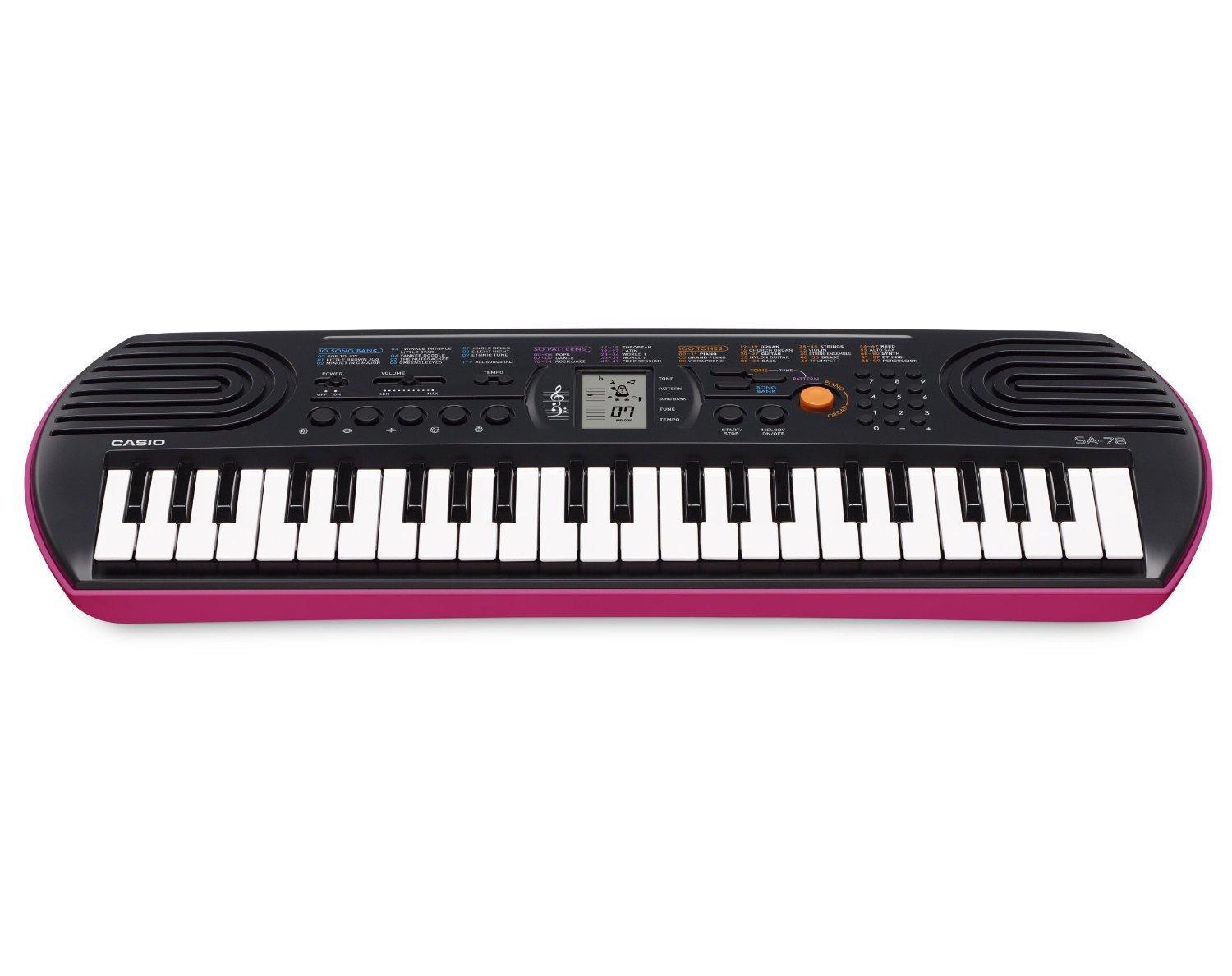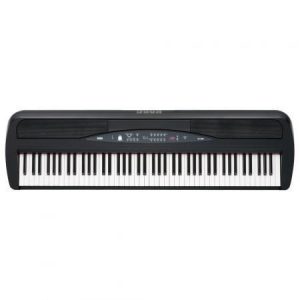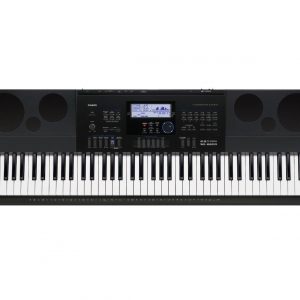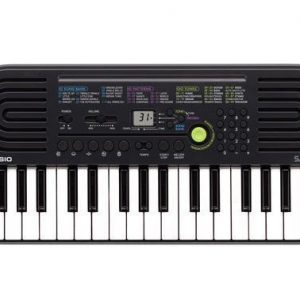Casio SA-78
$42.99
Get the Casio SA-78 keyboard today and experience the perfect blend of quality sound and affordability!
Compare
Description
The Casio SA-78 keyboard is a compact and versatile musical instrument designed for beginners and young aspiring musicians. It is an affordable yet feature-packed keyboard that offers an excellent platform for learning, practicing, and performing music.
The SA-78 keyboard features a 44 mini-size key layout that is easy to navigate and play. It includes a range of sounds and rhythms that cover a wide variety of musical genres. The keyboard offers 100 different tones, ranging from drums and percussion to guitars, wind instruments, and pianos. There are also 50 built-in rhythms that provide a complete accompaniment to the melodies you play.
One of the standout features of the Casio SA-78 keyboard is its melody sampling capability. This feature allows you to sample a sound or musical phrase and use it as a backdrop or accompaniment for your performance. You can also use the sampling function to record your own voice or sound and layer it over the built-in sounds and rhythms.
The SA-78 keyboard also features a LCD screen that displays various settings and functions. This allows you to easily navigate the different features and settings of the keyboard for efficient use. Additionally, it has an onboard stereo speaker system that delivers a clear and dynamic audio performance.
The keyboard is portable and lightweight, making it an ideal option for musicians who need to move around for their music gigs or practices. It runs on six AA batteries or AC power adapter, making it efficient in power consumption.
The SA-78 comes with a music rest that helps hold sheet music or songbooks. It also includes a headphone jack that lets you practice quietly without disturbing others.
Overall, the Casio SA-78 keyboard is a handy tool for those who want to explore music and learn new skills. It’s intuitive and easy to use, and its versatile features make it perfect for beginners and young musicians. With its affordable price, the SA-78 is an excellent investment for anyone who is passionate about music.
Casio SA-78 properties
| Product name |
SA-78 |
| Brand |
Casio |
| Type |
Keyboard Instruments |
| Keyboard Instrument |
Keyboard |
Frequently Asked Questions:
What is the maximum number of internal user songs that can be stored in Casio SA-78 keyboard?
The Casio SA-76 and SA-78 keyboards do not have an internal storage for user songs. They can only store 50 preset songs but these are factory-loaded and cannot be replaced or edited by the user.
How do I program and save a custom rhythm on the Casio SA-78 keyboard?
To program and save a custom rhythm on the Casio SA-78 keyboard, follow these steps:
1. Press the "Rhythm" button to select the Rhythm mode. Use the "Tempo" buttons to adjust the tempo of the rhythm you want to customize. Press the "Registro" button to access the Accompaniment Styles function. Press the "Style" button to cycle through the available styles until you find the one you want to modify. Use the "Variation" button to cycle through the different variations of the selected style. To customize the rhythm, use the "Chord" and "Instrument" buttons to change the chords and instruments used in the style. You can also adjust the volume of individual instruments using the "Level" sliders on the display screen. Once you have made all the necessary changes, press the "Store" button to save your custom rhythm. Use the "Register" buttons to select a blank register in which to store your new rhythm. Press the "Store More" button if you want to save additional custom rhythms in different registers. To access your saved rhythms, press the "Rhythm" button and use the "Register" buttons to select the register where your custom rhythm is stored. Remember to always save your work and avoid accidentally overwriting your creations by double-checking which register you are storing your rhythm in.
How do I properly program and save custom rhythms using the built-in Rhythm Editor feature on the Casio SA-78 keyboard?
To use the Rhythm Editor feature on your Casio SA-78 keyboard to create and save custom rhythms, follow these steps:
1. Press the [F1] button to enter the Rhythm Editor mode. Use the [CURSOR LEFT/RIGHT] buttons to select the desired rhythm element (such as bassline or drums), then use the [DATA IN/OUT] and [FUNCTION] buttons to edit its parameters. To add a new element, press the [ADD ELEMENT] button. You can then use the [CURSOR LEFT/RIGHT] buttons to select the type of element you want to add (such as melody or percussion), and then use the [DATA IN/OUT] and [FUNCTION] buttons to customize its settings. To delete an existing element, press the [DELETE ELEMENT] button. This will allow you to replace it with a new one or leave an empty space in your rhythm. When you're satisfied with your custom rhythm, save it by pressing the [STORE RHYTHM] button. You can then choose a location to save the rhythm (such as User Bank 1-64). To access your saved rhythms, press the [F2] button to enter the Sequence mode, and then use the [CURSOR LEFT/RIGHT] buttons to select the desired rhythm. You can then use the [PLAY] button to hear it, or the [RECORD] button to record a performance using your custom rhythm. Remember to always perform the task to the best of your ability and ensure that you have a solid understanding of the keyboard's features before attempting any advanced programming techniques.
How can I optimize the sound quality and functionality of a Casio SA-78 keyboard through professional maintenance and customization services?
To optimize the sound quality and functionality of a Casio SA-78 keyboard, we recommend seeking out professional maintenance and customization services. Here are some tips:
1. Regular Maintenance:
Regularly maintaining your Casio SA-78 keyboard can help prevent issues that may affect its sound quality and functionality. This includes cleaning the keys, checking for loose connections, and replacing worn-out parts as necessary. We recommend bringing your keyboard in for a professional tune-up at least once a year to ensure it's running smoothly. Sound Customization:
Customizing the sound of your Casio SA-78 can help you create more unique and expressive performances. This includes adjusting the volume, tone, and EQ settings, as well as adding external effects like reverb and delay. Our team of experts can work with you to find the perfect sound for your specific needs. Connectivity:
The Casio SA-78 is compatible with a variety of audio and MIDI inputs and outputs, allowing you to connect it to other devices and expand its functionality. Whether you want to use it as a MIDI controller or connect it to an external sound source, our customization services can help you achieve the desired connection. Repairs:
If your Casio SA-78 is experiencing any issues that affect its sound quality or functionality, we offer repair services to help get it back up and running. Our team of experts has the knowledge and experience necessary to diagnose and fix a wide range of keyboard problems. By utilizing these professional maintenance and customization services, you can optimize the sound quality and functionality of your Casio SA-78 keyboard and take your performances to the next level.
Frequenty asked questions about Casio SA-78
How to connect Casio SA-78 to computer?
Casio SA-78 keyboard is a standalone instrument that has its own sound engine. However you can connect it to a PC/Mac computer. It will significantly extend the functions and usability of the instrument. You can use USB-MIDI interface to control co called DAW Software like Ableton Live, Fl Studio, Logic Pro or Cubase to record MIDI notes and command or pure digital audio.
Click here for more informations about Keyboard to PC connectivity





Akaka –
The perfect instrument to start playing music. Especially useful when learning to read notes is the visualization of the pitch in the form of the appropriate note on the staff – bass and treble.
We only use it the second day, but for the money it’s a good product. Good workmanship, the keyboard works lightly, the number of sounds or foundations is sufficient for a few years old.
Adeline –
While Akaka’s review of the Casio SA-78 has been rated highly by others, I must respectfully disagree with some of his assertions. Firstly, while it’s true that this keyboard can be a great tool for learning to read music, I would argue that its usefulness goes beyond this. The ability to visualize notes on the staff is certainly helpful for beginners, but more advanced players may also find it beneficial as a way to reinforce note recognition and understanding. In fact, the Casio SA-78 could be a valuable addition to any musician’s arsenal, regardless of their skill level.
Akaka is right in noting that the keyboard is well-made and the keys respond lightly, but I would like to point out that the number of sounds and foundations available may not be enough for some users. While it’s true that a few years should suffice for most learners, more experienced musicians may find themselves wanting for more variety in their sound palette. Additionally, while Akaka seems satisfied with the quality of the keyboard itself, it’s worth mentioning that its features and capabilities are quite basic compared to more advanced models on the market.
It’s also important to consider the role that technology is playing in the music industry today. With the rise of digital production tools and software, many musicians are finding that they no longer need bulky keyboards like the Casio SA-78 in order to create their music. Instead, they’re relying on laptops, tablets, and smartphones equipped with virtual instruments and recording software. While there will always be a place for traditional instruments like this keyboard, it’s worth considering whether it’s still relevant in today’s rapidly evolving musical landscape.
In light of these factors, I would suggest that while the Casio SA-78 may be a good product for some users, it’s not necessarily the best choice for everyone. Those who are just starting out or have basic needs might find it more than sufficient, but more advanced musicians and producers may want to consider investing in more versatile and feature-rich alternatives.
As for today’s news, there’s been a lot of buzz in the industry recently about Nike’s decision to focus more heavily on classic basketball shoes like the Air Force 1. While some fans of the brand are excited by this move, others are worried that it could be putting sales at risk as competitors like On and Deckers-owned Hoka steal market share. Analysts suggest that Nike may have become too attached to legacy products, leading to cutbacks in supplies for existing lines and a focus on new launches. While the company has doubled its SNKRS app’s Air Jordan 1 High releases, shoppers are increasingly favoring newer trends towards dad shoes and terrace styles. Upcoming running category products may help combat slowdowns in retro business, but some investors are questioning their popularity.
As a musician and music technology enthusiast, I’m always on the lookout for new innovations and trends that could impact the industry. While it’s true that traditional instruments like the Casio SA-78 will likely continue to hold a place in many musicians’ hearts and collections, it’s also clear that we’re living in a rapidly changing musical landscape. As technology continues to evolve at breakneck speed, it’s important for musicians of all levels to stay informed and adaptable as they navigate these new waters.
In closing, while I appreciate Akaka’s enthusiasm for the Casio SA-78, I would encourage others to consider the broader context in which this product exists. While it may be a good choice for some users, it’s important to remember that there are many other options available in today’s music tech landscape. As always, it’s up to individual musicians and producers to determine what works best for them based on their own needs and preferences.